BAROQUE ART IN NAXXAR
TITULAR PAINTING – THE NATIVITY OF OUR LADY The altar painting of the NATIVITY OF THE VIRGIN, is attributed to Guiseppe d’Arena. Datable to c. 1705, it is wonderfully composed and executed at a high level of finish throughout. The painting encompasses Pretian modes with a manner that remarkably anticipates mid-eighteenth century works in Malta.
 D’Arena is not known to have replicated or copied Preti’s work, even though it can be presumed that he did. In any case he did make numerous conscious citations of Preti’s works and frequently took figures directly from the master’s compositions and placed them in his own works.
Preti’s influence is particularly manifest in the rendition of the closely knit, low-lying group of maidens attending the new-born child in the immediate distance. Their monumental muscular stance, mannerisms, and clothing recall the typical female Pretian type. The rendition of the cherubs and putti hovering above the scene amidst billowing draperies and open architecture will, on the other hand, later reappear in the work of Francesco Zahra (1710-73). Compositionally, the work is well structured with a recession of planes and a background bedroom scene well integrated through the architectural setting. A bright palette illuminates the work. It is not clear whether an archival record dated 1700 for an unspecified but remarkably expensive painting costing 150 scudi refers, as probable, to this painting.
D’Arena is not known to have replicated or copied Preti’s work, even though it can be presumed that he did. In any case he did make numerous conscious citations of Preti’s works and frequently took figures directly from the master’s compositions and placed them in his own works.
Preti’s influence is particularly manifest in the rendition of the closely knit, low-lying group of maidens attending the new-born child in the immediate distance. Their monumental muscular stance, mannerisms, and clothing recall the typical female Pretian type. The rendition of the cherubs and putti hovering above the scene amidst billowing draperies and open architecture will, on the other hand, later reappear in the work of Francesco Zahra (1710-73). Compositionally, the work is well structured with a recession of planes and a background bedroom scene well integrated through the architectural setting. A bright palette illuminates the work. It is not clear whether an archival record dated 1700 for an unspecified but remarkably expensive painting costing 150 scudi refers, as probable, to this painting.
SOPRAQUADRO – THE ETERNAL FATHER The sopraquadro of The Eternal Father is even closer to Preti. It follows a type of representation of the Eternal Father imparting blessing and seated on globe-like clouds which, established by Preti, became exceedingly popular as sopraquadri for titular paintings.
 Stefano Erardi
Stefano Erardi
The large altar laterals are by Stefano Erardi (1630-1716) and are amongst the better productions of the late years of his remarkably prolific oeuvre. Erardi was the most talented of the native painters and deserves credit for being able to maintain his own artistic identity without slavishly falling under the spell of Mattia Preti. Despite being of an appreciably good standard, his art was, however, stylistically somewhat retardataire and still largely dependent on the Bolognese painters of the early seicento. He adopted a formula for the depiction of figures that he repeated throughout his maturity and his oeuvre contains many elements of déjà` vu.
ADORATION OF THE MAGI

THE FLIGHT INTO EGYPT
 The Adoration of the Magi is an inverse variation of his most prestigious commission, a similar subject for the chapel of Germany in the conventual church of St John’s, Valletta. The latter is an earlier work, larger and more refined in execution. The Flight into Egypt is more dynamic, compositionally based on a right to left movement supported by the rising diagonal of gestures and facial expression. Its iconography provides interesting reading. The Virgin, in middle distance, embraces the Child with tender warmth, whilst a hovering angel indicates the protective embrace of the dove of the Holy Spirit to Joseph. Beneath the angel is a young putto who indicates the direction along the path that the party must follow on its journey to Egypt. An idol falls behind their back. Colour plays a compositional role. Especially dominating is the intense yellow ochre that rises like a vortex to display the dove of the Holy Spirit against a much cooler representation of the earthly landscape. The figures are well modelled and drawn.
The Adoration of the Magi is an inverse variation of his most prestigious commission, a similar subject for the chapel of Germany in the conventual church of St John’s, Valletta. The latter is an earlier work, larger and more refined in execution. The Flight into Egypt is more dynamic, compositionally based on a right to left movement supported by the rising diagonal of gestures and facial expression. Its iconography provides interesting reading. The Virgin, in middle distance, embraces the Child with tender warmth, whilst a hovering angel indicates the protective embrace of the dove of the Holy Spirit to Joseph. Beneath the angel is a young putto who indicates the direction along the path that the party must follow on its journey to Egypt. An idol falls behind their back. Colour plays a compositional role. Especially dominating is the intense yellow ochre that rises like a vortex to display the dove of the Holy Spirit against a much cooler representation of the earthly landscape. The figures are well modelled and drawn.
BAPTISM OF JESUS CHRIST The Baptism of Christ, titular of the church of St John the Baptist, is an early work which is not, however, entirely successful. The church had been remodelled in the early eighteenth century and Buhagiar was commissioned its decoration. Apart from the titular, he also later painted the two small laterals of The Nativity of the Baptist and The Beheading of the Baptist, together with a small oval of the Visitation above the main doorway. A 1745 reference that notes payment of 35.10 scudi for two unspecified works from an unnamed painter should probably refer to the two laterals. The date and amount paid buttress this suggestion.
The Baptism of Christ, titular of the church of St John the Baptist, is an early work which is not, however, entirely successful. The church had been remodelled in the early eighteenth century and Buhagiar was commissioned its decoration. Apart from the titular, he also later painted the two small laterals of The Nativity of the Baptist and The Beheading of the Baptist, together with a small oval of the Visitation above the main doorway. A 1745 reference that notes payment of 35.10 scudi for two unspecified works from an unnamed painter should probably refer to the two laterals. The date and amount paid buttress this suggestion.


THE BEHEADING OF THE BAPTIST
THE VIRGIN OF LIGHT  The altar painting of The Virgin of Light, now in the parish museum should be ascribed to Gio. Nicola Buhagiar and not to Francesco Zahra. The work is documented to 1738 for a cost of 60 scudi but, unfortunately, the artist is not mentioned. It is true that, in this period, Buhagiar and Zahra were stylistically close, but a technical reading of the brushwork points towards the former.
Compositionally it follows the traditional structure of the Virgin of Light, a devotion that became increasingly popular in the first half of the eighteenth century. At Naxxar, this devotion was installed in place of the altar of St Agatha in 1738, only to be replaced around 1753 by the devotion to Our Lady of Sorrows.
The altar painting of The Virgin of Light, now in the parish museum should be ascribed to Gio. Nicola Buhagiar and not to Francesco Zahra. The work is documented to 1738 for a cost of 60 scudi but, unfortunately, the artist is not mentioned. It is true that, in this period, Buhagiar and Zahra were stylistically close, but a technical reading of the brushwork points towards the former.
Compositionally it follows the traditional structure of the Virgin of Light, a devotion that became increasingly popular in the first half of the eighteenth century. At Naxxar, this devotion was installed in place of the altar of St Agatha in 1738, only to be replaced around 1753 by the devotion to Our Lady of Sorrows.
THE ASSUMPTION OF THE VIRGIN The slightly-later painting of The Assumption of the Virgin displays more of Gio. Nicola Buhagiar’s mature characteristics. The crowded composition, the apostles that inhabit their pictorial space with great difficulty, and the elongation of the figures are typical of the artist. The painting, now transeptal titular in the parish church, was transferred there from its original location in the church of Santa Marija tax-Xaghra in the immediate post-Second World War years. The painting dates to 1740 and cost 75 scudi.
The slightly-later painting of The Assumption of the Virgin displays more of Gio. Nicola Buhagiar’s mature characteristics. The crowded composition, the apostles that inhabit their pictorial space with great difficulty, and the elongation of the figures are typical of the artist. The painting, now transeptal titular in the parish church, was transferred there from its original location in the church of Santa Marija tax-Xaghra in the immediate post-Second World War years. The painting dates to 1740 and cost 75 scudi.

The Virgin and Child and Saints Cajetan, Paul, John the Evangelist, and Francis of Padua, now in the parish museum, is a later work and has also been often confused with the work of Francesco Zahra. The painting is, however, documented to Buhagiar and it appears to have been executed between October 1745, when 2.6 scudi were paid for its stretcher, and January 1746, when Buhagiar received 71 scudi for the work. The latter included 3 scudi for the canvas. The modelling of figures and the handling of the brush is very close of his Virgin of Charity in the Zebbug parish church. The painting was the titular of the altar of Saints Paul and Cajetan in the parish church. The representation of the infant Christ in the St Cajetan painting is very similar to that of the small devotional painting of The Infant Christ in the parish museum. The attribution of the latter to Buhagiar is correct, especially buttressed by the dark outlining of the flesh tones which is so typical of Buhagiar’s technique. The artist produced a number of similar representations for other parishes.
THE INFANT JESUS
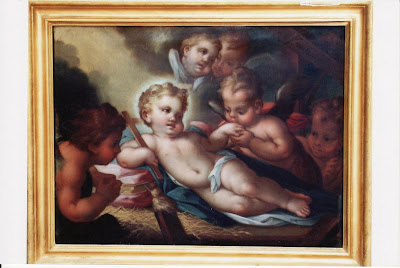 Francesco Zahra (1710 – 1773)
The numerous paintings which Francesco Zahra painted for the Naxxar parish church are testimony of a remarkable affinity between the church authorities and Malta’s leading native artist. The paintings, however, all stylistically date to post 1740 when Zahra gradually put aside the stylistic manner of Gio. Nicola Buhagiar that had so greatly influenced him in his early years and developed a more personal style which was to reach its best performances in the late 1750s. By the early 1740s Zahra had already taken the lead over Buhagiar and Regnaud, outclassing them in both technical and compositional considerations. Whilst both Buhagiar and Regnaud made little changes of style throughout their careers and remained content with the kind of work they produced when still in their twenties, Zahra progressed remarkably well and his style changed as he matured. It is true that the artist still stuck to certain formulas of representation but his creativity compensated for the repetition of facial types.
Francesco Zahra (1710 – 1773)
The numerous paintings which Francesco Zahra painted for the Naxxar parish church are testimony of a remarkable affinity between the church authorities and Malta’s leading native artist. The paintings, however, all stylistically date to post 1740 when Zahra gradually put aside the stylistic manner of Gio. Nicola Buhagiar that had so greatly influenced him in his early years and developed a more personal style which was to reach its best performances in the late 1750s. By the early 1740s Zahra had already taken the lead over Buhagiar and Regnaud, outclassing them in both technical and compositional considerations. Whilst both Buhagiar and Regnaud made little changes of style throughout their careers and remained content with the kind of work they produced when still in their twenties, Zahra progressed remarkably well and his style changed as he matured. It is true that the artist still stuck to certain formulas of representation but his creativity compensated for the repetition of facial types.THE VIRGIN OF THE ROSARY
 The first altar paintings that Zahra produced for the parish church date to the late 1740s and are The Virgin of the Rosary, dated 1748, and The Martyrdom of St Lawrence, dated 1749. The latter is an interesting painting, crowded but well-conceived and structured. The pose of Saint Lawrence is a borrowing from Preti, who always remained a source of inspiration for Zahra. The colour scheme and the rendition of drapery folds are typical of his mid-period, of which this painting is an early example.
The Virgin of the Rosary has many stylistic elements that are characteristic of the period, namely the slight elongation of the figures, the broad broken drapery, and the oval elongation of the female faces. The painting follows the typical sacra conversazione pyramidal format with a centrally-elevated Madonna and Child and with Saints Dominic and Catherine of Siena kneeling at a lower level. This device was re-utilised by Zahra in a number of Rosary altar paintings he painted for other parishes. The closest stylistic counterpart of this work is his Rosary painting for the Attard parish church, which belongs to the same period.
The small paintings of the Rosary Mysteries, inset within the stone carved reredos, are not by Zahra and should date to the seventeenth century. They are mediocre productions of very limited interest.
The first altar paintings that Zahra produced for the parish church date to the late 1740s and are The Virgin of the Rosary, dated 1748, and The Martyrdom of St Lawrence, dated 1749. The latter is an interesting painting, crowded but well-conceived and structured. The pose of Saint Lawrence is a borrowing from Preti, who always remained a source of inspiration for Zahra. The colour scheme and the rendition of drapery folds are typical of his mid-period, of which this painting is an early example.
The Virgin of the Rosary has many stylistic elements that are characteristic of the period, namely the slight elongation of the figures, the broad broken drapery, and the oval elongation of the female faces. The painting follows the typical sacra conversazione pyramidal format with a centrally-elevated Madonna and Child and with Saints Dominic and Catherine of Siena kneeling at a lower level. This device was re-utilised by Zahra in a number of Rosary altar paintings he painted for other parishes. The closest stylistic counterpart of this work is his Rosary painting for the Attard parish church, which belongs to the same period.
The small paintings of the Rosary Mysteries, inset within the stone carved reredos, are not by Zahra and should date to the seventeenth century. They are mediocre productions of very limited interest.
 MARTRYDOM OF ST LAWRENCE
The St Lawrence has all the qualities which makes a work easily appealing, and so it was for the parish of Naxxar.
It is interesting to compare it stylistically with the St Cajetan by Buhagiar, which belongs to the same period. Even though there still are some stylistic similarities, Zahra’s treatment of mass is different and much bolder. Zahra’s brush flows with greater ease and the chromatic scheme is different.
MARTRYDOM OF ST LAWRENCE
The St Lawrence has all the qualities which makes a work easily appealing, and so it was for the parish of Naxxar.
It is interesting to compare it stylistically with the St Cajetan by Buhagiar, which belongs to the same period. Even though there still are some stylistic similarities, Zahra’s treatment of mass is different and much bolder. Zahra’s brush flows with greater ease and the chromatic scheme is different.
 The next altar painting was The Virgin of Sorrows with Saints Philip Benizi and Agatha, dated 1753. The painting dates to the later years of Zahra’s mid-period, when the colour scheme starts getting chromatically intense, the drapery folds heavier and the facial types rounder. The St Agatha anticipates the female form that he later used in the ceiling decoration for the Mdina cathedral chapter hall. For the painting, Zahra received 60.6 scudi on 3 February 1753.
The painting was commissioned to substitute the altar painting of The Virgin of Light, painted by Buhagiar only a couple of years earlier. The substitution of the devotion on the altar led the procurators simultaneously to commission from Zahra a small painting of The Virgin of Light to hang as a sub-titular. The painting, today in the parish museum, is dated 1752. The work follows the traditional compositional scheme of the Virgin of Light. Its small size shows Zahra’s ability to handle a small brush with a remarkable degree of freshness.
THE EVANGELISTS
The next altar painting was The Virgin of Sorrows with Saints Philip Benizi and Agatha, dated 1753. The painting dates to the later years of Zahra’s mid-period, when the colour scheme starts getting chromatically intense, the drapery folds heavier and the facial types rounder. The St Agatha anticipates the female form that he later used in the ceiling decoration for the Mdina cathedral chapter hall. For the painting, Zahra received 60.6 scudi on 3 February 1753.
The painting was commissioned to substitute the altar painting of The Virgin of Light, painted by Buhagiar only a couple of years earlier. The substitution of the devotion on the altar led the procurators simultaneously to commission from Zahra a small painting of The Virgin of Light to hang as a sub-titular. The painting, today in the parish museum, is dated 1752. The work follows the traditional compositional scheme of the Virgin of Light. Its small size shows Zahra’s ability to handle a small brush with a remarkable degree of freshness.
THE EVANGELISTS
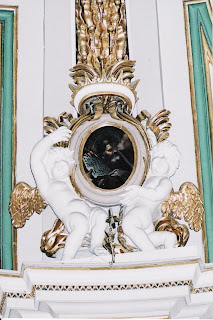
 To the same period date the four small oval paintings of the Evangelists which hang within carved medallions held by putti above the cornice in the choir. The four paintings were paid in two instalments of 5 scudi each in September 1754 and February 1755 respectively. The saints are represented in quarter-length, holding a scroll with large-lettered inscriptions to be visible from the choir floor. The saints’ faces belong to Zahra’s usual repertoire, which he repeats over and over again. The face of St John is, for example, identical in modelling to that of St Lawrence in the latter’s altar painting.
To the same period date the four small oval paintings of the Evangelists which hang within carved medallions held by putti above the cornice in the choir. The four paintings were paid in two instalments of 5 scudi each in September 1754 and February 1755 respectively. The saints are represented in quarter-length, holding a scroll with large-lettered inscriptions to be visible from the choir floor. The saints’ faces belong to Zahra’s usual repertoire, which he repeats over and over again. The face of St John is, for example, identical in modelling to that of St Lawrence in the latter’s altar painting.
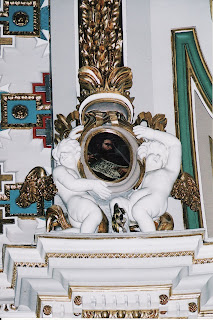
 The parish museum houses a number of other small devotional paintings by Zahra which are of considerable interest. The tabernacle door of the Salvator Mundi belongs to the mid-period and is similar to a number of others he produced. The St Ignatius of Loyola is compositionally derived from the remarkable altar painting of the same saint in the Jesuit church at Valletta. The St Aloysius Gonzaga, dated 1761, is another example of Zahra’s aptitude for small-scale representations.
The parish museum houses a number of other small devotional paintings by Zahra which are of considerable interest. The tabernacle door of the Salvator Mundi belongs to the mid-period and is similar to a number of others he produced. The St Ignatius of Loyola is compositionally derived from the remarkable altar painting of the same saint in the Jesuit church at Valletta. The St Aloysius Gonzaga, dated 1761, is another example of Zahra’s aptitude for small-scale representations.
 ST IGNATIUS OF LOYOLA and ST ALOYSIUS GONZAGA
ST IGNATIUS OF LOYOLA and ST ALOYSIUS GONZAGA 
 In 1762 Zahra completed the decoration of the church of St John the Baptist with the execution of the remaining two small laterals representing St John the Baptist Preaching and The Taking of St John the Baptist. Both paintings are compositionally derived from Preti’s representations in the ceiling of St John’s conventual church. They fail to achieve, however, the standard of Zahra’s other works.
In 1762 Zahra completed the decoration of the church of St John the Baptist with the execution of the remaining two small laterals representing St John the Baptist Preaching and The Taking of St John the Baptist. Both paintings are compositionally derived from Preti’s representations in the ceiling of St John’s conventual church. They fail to achieve, however, the standard of Zahra’s other works.
ST JOHN BAPTIST PREACHING
DEATH OF ST JOHN BAPTIST
 The extent to which Zahra explored the art of Mattia Preti is best exemplified in the altar painting representing the miracle of the viper in the church of St Paul at San Pawl tat-Tarġa. The painting is quite obviously derived from Preti’s lateral painting of the same subject in the choir of the cathedral church in Mdina. The composition has been adjusted and the narrative slightly modified, but Zahra approaches the figure representation with a monumentality which is rarely so close to Preti. This is especially noted in the figure of St Paul. The painting was privately donated and carries the coat-of-arms of the Bugeja-Schembri family. Its expenditure is therefore not documented in the church archives, but a note of 29 September 1747 recording the payment of 6 tari for the transportation of a painting of St Paul to the little church of St Paul should refer to this painting.
The extent to which Zahra explored the art of Mattia Preti is best exemplified in the altar painting representing the miracle of the viper in the church of St Paul at San Pawl tat-Tarġa. The painting is quite obviously derived from Preti’s lateral painting of the same subject in the choir of the cathedral church in Mdina. The composition has been adjusted and the narrative slightly modified, but Zahra approaches the figure representation with a monumentality which is rarely so close to Preti. This is especially noted in the figure of St Paul. The painting was privately donated and carries the coat-of-arms of the Bugeja-Schembri family. Its expenditure is therefore not documented in the church archives, but a note of 29 September 1747 recording the payment of 6 tari for the transportation of a painting of St Paul to the little church of St Paul should refer to this painting.
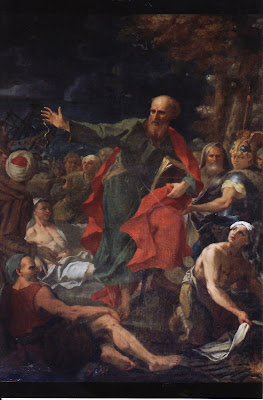

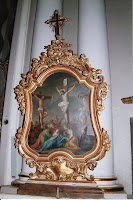
 The best work is by far Giuseppe Cali’s 1916 altar painting of The Virgin of Sorrows, now in the parish museum. Cali’ became Malta’s most competent and prolific artist of the turn of the century and his art was very much in demand by ecclesiastical authorities. The Virgin of Sorrows is a late work, somewhat retardataire for the period, but still a remarkable reflection of the artist’s romanticised treatment of his religious subjects. An element of intense religious piety pervades the work in an interesting interplay between the Virgin, the dead Christ, and the setting. The work is, however, unfortunately marred by the discolouring of the varnish. A very close thematic and stylistic counterpart is his 1915 Entombment of Christ in the parish church of St Paul’s Bay. Despite his old age, Cali’ maintained wonderful control of his drawing and of the brush.
The best work is by far Giuseppe Cali’s 1916 altar painting of The Virgin of Sorrows, now in the parish museum. Cali’ became Malta’s most competent and prolific artist of the turn of the century and his art was very much in demand by ecclesiastical authorities. The Virgin of Sorrows is a late work, somewhat retardataire for the period, but still a remarkable reflection of the artist’s romanticised treatment of his religious subjects. An element of intense religious piety pervades the work in an interesting interplay between the Virgin, the dead Christ, and the setting. The work is, however, unfortunately marred by the discolouring of the varnish. A very close thematic and stylistic counterpart is his 1915 Entombment of Christ in the parish church of St Paul’s Bay. Despite his old age, Cali’ maintained wonderful control of his drawing and of the brush.

.jpg)


